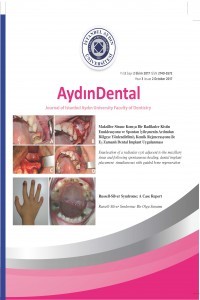KAZANILMIŞ MAKSİLLER DEFEKTLİ HASTALARDA PROTETİK TEDAVİNİN BAŞARISINDA 3D DİJİTAL SİSTEMLERİN ETKİSİNİN DEĞERLENDİRİLMESİ
Maksiller defekt, Obtüratör, 3D Dijital sistemler
EVALUATION OF THE EFFECT OF 3D DIGITAL SYSTEMS ON THE SUCCESS OF PROTHETIC TREATMENT IN PATIENTS WITH ACQUIRED MAXILLARY DEFECTS
Maxillary defect, Obturator, 3D Digital systems,
___
- 1. Keskin H, Özdemir T. Çene Yüz Protezleri, 1. Baskı İstanbul; Diş Hekimliği Yayınları. 1995:1-45
- 2. Keskin K, Uygun N, Somtürk E, Derviş E, Karakullukçu A, İyigün D. Kazanılmış defektli maksillofasial hastalarda tedavi obtürasyonu. İstanbul Üniv. Diş Hek. Fak. Derg. Aralık 1992;26(4):191-200
- 3. Taylor TD. Clinical Maxillofacial Prosthetics, 1st ed. China;2000 Quintessence Publishing Co.Inc :103-9
- 4. Akay C, Yaluğ S. Kısmi maksillektomi yapılmış hastaların bukkal uzantılı obturatör ile protetik rehabilitasyonu: Vaka raporu. Atatürk Üniv. Diş Hek. Fak. Derg. 2014; 24(2):278-282
- 5. Şeker E, Kayış M. Parsiyel maksillektomi vakalarının implantüstü ber ve doğal diş destekli bukkal flanj obturatörler ile rehabilitasyonu: 2 Vaka raporu. A.Ü. Diş Hek. Fak. Derg. 2016; 43(3):179-185
- 6. Tunçdemir AR, Sari F. Fabricating a hollow bulb obturator. Cumhuriyet Dent J. 2013; 16(1):61-65
- 7. Akay C, Yaluğ S, Dalkız M. Effects of dental and zygomatic implants on stress distribution in zygomatic bone. Süleyman Demirel Üniv. Mühendislik Bilimleri ve Tasarım Derg. 2014; 253-259 ISSN: 1308-6693
- 8. Ademhan O, Tükel C, Küçükkurt S. Maksillofasiyal cerrahide CAD/CAM sistemlerinin kullanımı. Aydın Dental, April 2017; 3(1):43-52
- 9. Murat S. Maksillektomi defektlerinde konik ışıklı bilgisayarlı tomografi ve steriolitografi kullanılarak üretilen obturator bulblarının doğruluğunun değerlendirilmesi: Ex vivo çalışma. JAREM. 2018; 8(3):186-90
- 10. Korkmaz FM, Kocacıklı M, Korkmaz T. Maksiller obturatörlerde dental ve zigomatik implant seçimi. ADO Klinik Bilimler Derg. 2009; 3(1):295-99
- 11. Mentag PJ, Kosinski TF. Increased retention of a maxillary obturator prosthesis using osteointegrated intramobile cylinder dental implants: A clinical report. J PROSTHET DENT, 1988; 60(4):411-15
- 12. Aramany MA. Basic principles of obturator design for partially edentulous patients. Part I: Classification. J.PROSTHET DENT, 1978; 40(5):554-57
- 13. Koyama S, Kato H, Harata T, Sasaki K. A workflow for fabricating a hollow obturator by using 3D digital technologies. J.PROSTHET DENT, 2020; 123(4):648-52
- 14. Tasopoulos T, Chatziemmanouil D, Karaiskou G, Kouveliotis G, Wang J, Zoidis Panagiotis. Fabrication of a 3D-printed interim obturator prosthesis: A contemporary approach. J PROSTHET DENT, 2019; 121(6):960-63
- 15. Hongqiang Y, Qujun M, Yuezhong H, Man L, Yongsheng Z. Generation and evaluation of 3D digital casts of maxillary defects based on multisource data registration: A pilot clinical study. J PROSTHET DENT, 2017; 118(6):790- 95
- 16. Londono J, Abreu A, Baker PS, Furness AR. Fabrication of a definitive obturator from a 3D cast with a chairside digital scanner for a patient with severe gag reflex:A clinical report. J PROSTHET DENT, 2015; 114(5):735-38
- 17. Kortes J, Dehnad H, Kotte ANT, Fennis WMM, Rosenberg AJWP. A novel digital workflow to manufacture personalized threedimensional- printed hollow surgical obturators after maxillectomy. Int J Oral Maxillofac Surg. 2018; 47(9):1214-18
- 18. Murat S, Gürbüz A, Kamburoğlu G. Fabrication of obturator prosthesis by fusing CBCT and digital impression data. Int J Computerized Dent, 2018; 21(4):335-44
- 19. Roslan H, Shahabudin S. Palatal obturator prosthesis. Cumhuriyet Dental J, 2018; 21(1):55-60
- 20. Sinn DP, Cillo JE, Jr., Miles BA. Stereolithography for craniofacial surgery. J Craniofac Surg. 2006; 17:869-75
- 21. Marro A, Bandukwala T, Mak W. Three dimentional printing and medical Imaging: A rewiew of the methods and applications.Curr Probl Diagn Radiol. 2016; 45:2-9
- 22. Beumer J III, Curtis TA, Marunick MT. Maxillofacial Rehabilitation, Prosthetic and Surgical Considerations. Ishiyaku Euro America, Inc, 1996: 240-54
- 23. Kraeima J, Schepers RH, Van Ooijen PM, Steenbakkers RJ, Roodenburg JL, Witjes MJ. Integration of oncologic margins in threedimensional virtual planning for head and neck surgery,including a validation of the software pathway. J Craniomaxillofac Surg. 2015; 43:1374-79
- 24. Park JH, Leek S, Lee JY, Shin SW. Fabricating a maxillary obturator using an intraoral dijital impression: A case history report. Int J Prosthodont, 2017; 30:266-68
- 25. Bosh G, Ender A, Mahl A. A 3-dimentional occurarcy analysis of chairside CAD/CAM milling processes. J Prosthet Dent, 2014; 112:1425-31
- ISSN: 2149-5572
- Yayın Aralığı: Yılda 3 Sayı
- Başlangıç: 2015
- Yayıncı: İstanbul Aydın Üniversitesi
İMPLANT ÜSTÜ OVERDENTURE PROTEZLERDE TEK ATAŞMAN SİSTEMLERİ
Merve DEDE, Onur GEÇKİLİ, Fatma ÜNALAN
GENEL ANESTEZİ ALTINDA YAPILAN DENTAL TEDAVİLERİN UZUN DÖNEM BAŞARI ORANLARI
ORAL VE MAKSILLOFASIYAL TRAVMADA OPTIK NÖROPATI
Nima MOHARAMNEJAD, Behnam BOHLULİ, Ata GARAJEİ
Muhammed GÜRCAN, Nourtzan KECHAGIA, Burcu Ece KORU, Sanaz SADRY
MADEN İŞÇİLERİNDE PERİODONTAL SAĞLIK DURUMUNUN YAŞAM KALİTESİNE ETKİSİ
E. Nihan ATALAY, M. İnanç CENGİZ, Doğukan SEVLİ, Çağatay BÜYÜKUYSAL
ALT DUDAKTA KRONİK MUKOSEL TEDAVİSİ: OLGU SUNUMU
Saad Shahnawaz AHMED, Hira ZAMAN
AMELOGENEZİS İMPERFEKTALI GENÇ ERİŞKİN BİR HASTANIN GEÇİCİ ESTETİK REHABİLİTASYONU: BİR OLGU RAPORU
